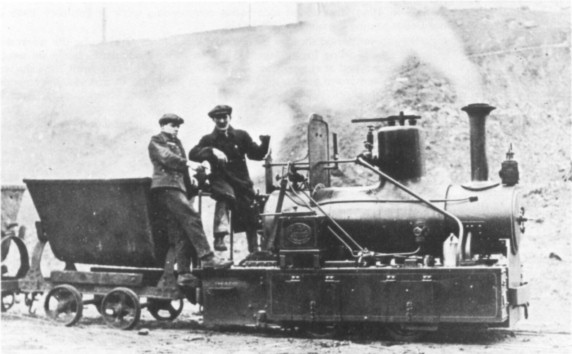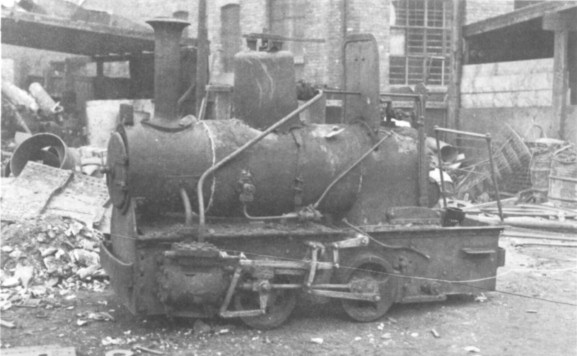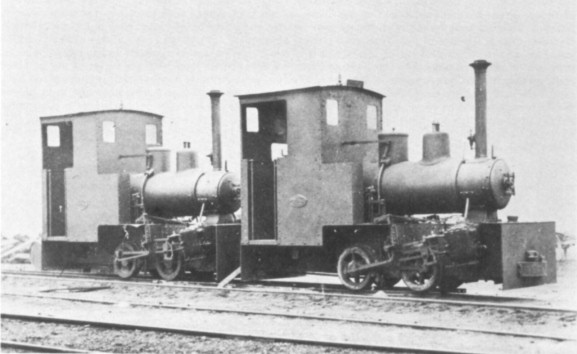
| THE INDUSTRIAL RAILWAY RECORD |
© OCTOBER 1973 |
PICTURE PARADE
TREVOR J. LODGE
'The Gasworks Scene' in RECORD 36, page 50, dealt briefly with 'some typical standard gauge locomotives employed at gasworks. The first part of these notes concerns a little known narrow gauge system which was used at Bradford Road Gasworks, Manchester, about which member Bob Fysh would like to know more following his acquisition of a photograph of one of the locomotives employed there.
The narrow gauge railway at Bradford Road was used to convey coke from the coke screening plant to the carburetted water gas plant, a distance of approximately ¼ mile. At the water gas plant the coke trucks were handled manually into one of two hydraulically operated lifts, which conveyed them to the upper floor of the plant, where they were pushed on to a short section of track and then tipped into trackless trucks. These trucks were then manoeuvred to any of the eight plants within the building and the coke finally fed into the generators.
Two locomotives, 3 and 4, are known to have worked on the system: both were built by Andrew Barclay, as were most of the standard gauge engines used at the works over the years. According to the Station Engineer, the narrow gauge locomotives were sold for scrap about 1946, but the system continued in use until about 1953 with horses and a road tractor as motive power. In 1950 the loco shed was still in existence but it was demolished and then this and the whole of the track area was eventually covered over to make way for new gas making plant. From time to time sections of old track are revealed during the course of excavations, and one short stretch which survives has a gauge of 36½ inches.
The first photograph, taken by the late G.W. Smith about 1920 (and sent by Bob Fysh) shows 4, one of the 2‑2‑0 well tanks used. These diminutive (3ft gauge) locomotives had 4½in by 8in cylinders and 1ft 6in diameter wheels: built by Andrew Barclay (1468 of 1916 and 1557 of 1917) they were numbered 3 and 4 respectively. Society records show that both were sold for scrap to James Moores (1936) Ltd of Bradford, Manchester; 3 about 1940 and 4 in September 1948. Compare the first view of 4 with one of the same locomotive taken by C.A. Appleton in Moores' yard in October 1948: this shows the motion quite clearly and dispels any ideas gained from a casual glance that the loco was an 0‑4‑0 well tank. Note that there is a reversing quadrant on each side of the footplate! A point of interest is raised by a statement from the Station Engineer who understood that both locos were purchased about 1898. Could it be that 3 and 4 replaced an earlier pair of narrow gauge locomotives, possibly 1 and 2?


Apparently Mr Smith was something of an industrial enthusiast but he suffered from a disability which prevented him from travelling far from his home in Manchester. The final photograph was taken about 1920 and shows two narrow gauge well tanks, possibly at Miles Platting, Manchester. These are two of Robert Hudson's 'Class A' locomotives, actually built by Hudswell Clarke. Note the chimneys of almost drain-pipe dimensions! Ron Redman has kindly provided information on this, the smallest type of locomotive ever built by Hudswell Clarke at the Railway Foundry: gauge 2ft 0in; cylinders 5in by 8in (and the smallest diameter cylinders ever used by Hudswell Clarke); wheel diameter 1ft 8in; rating 15hp; weight empty 3ton 18cwt; weight in working order 4ton 13cwt. The prototype of the class was Hudswell Clarke 962, this number being carried on a Hudson plate as the locomotive was supplied by Robert Hudson to B.K. Ghose & Co in India; it was ex‑works on 16th November 1911. Of the 36 locomotives in the class, several were used in the construction of various military establishments: Ripon Camp (8 locos), Richmond Camp (2 locos), and Abergele Camp (4 locos). Two of these, Hudswell Clarke 1160 and 1170 (both built 1915), eventually found their way to J. Dickenson (Bolton) Ltd and are possibly the subject of Mr Smith's photograph.

'It seemed to me in 1914 that England, unprepared for war,
managed to get into her stride with remarkable rapidity. I had been given by
Frank Baines, then Director of Works, the job of getting the timber he and
'Monty' Meyer had bought from Sweden to camps in North Wales, Cannock Chase,
Oswestry and Sherwood Forest. I had as assistant a clerk of works named
Trowbridge, a big man in every way, with a strong West Country accent. We
visited all four camps, decided where the timber should be delivered, and made
arrangements to hire or buy saw benches. We tried a petrol engine on one but it
had to be replaced by steam - a commentary on the petrol engine in 1914! ... It
was not long before difficulties began to arise, first at Cannock Chase, where
it was reported that deliveries were at a standstill. Collecting Trowbridge, off
I went to inspect. In the Cannock goods-yard, we found an enormous circus
traction engine with great wheels and the name 'Little Alf' inscribed on a small
brass plate. It seemed that 'Little Alf' had been used to haul trucks of timber
up the heather-lined tracks on the Chase, and the great wheels with heavy ribs
had cut the road to pieces. ... The works at the top of the Chase were isolated
and deliveries of timber were out of the question. Near the road at the foot of
the Chase was a colliery building. ... Smethurst [the colliery manager] said he
could lay a railway from his colliery sidings up the side of the heather-lined
track and so reach the camp; provided he could commandeer some disused sleepers
with 'chairs' attached. We surveyed the proposed route that night... We got Army
approval within 48 hours and Smethurst began work, blasting a gravel bank out of
the way. In three weeks he built three miles of railway which, though
having steep gradients, permitted the timber, hauled by two engines, to get over
the top and service not only our hutted camp but another Army camp which had got
into similar difficulties nearby.'
(Extract from 'Memoirs of an Architect' by Sir Thomas Bennett, which appeared in
'Building' for 24th March 1972. MJH)
Garswood Hall Collieries (Lancs). - 'The principal workshops
of the company are placed near the Western collieries, where the two large
winding engines erected at Nos.3 and 5 shafts were built, a special shed being
made for their construction; also two locomotives, now running on the works,
were built here...'
('Colliery Guardian,' 9th December 1892. JAP)
"Messrs. Pinto, Basto and Co., of Lisbon, are prepared to
receive written PROPOSALS for the PURCHASE of all or any part of the ROLLING
STOCK and MATERIAL existing at the different stations in Portugal of the late
LISBON STEAM TRAMWAYS COMPANY, and also for the purchase of the station
buildings, workshops, and of the land on which the stations are built. The
material comprises 1700 tons of rails, Jignolle [sic] pattern, 40lb.; 16 locomotives, built by Messrs. Sharp, Stewart, and Co., of Manchester; 70 carriages of different classes ; 80 low‑sided goods waggons ; .... "
("Iron," 16th June 1877. This advertisement would seem to
confirm that all sixteen locomotives did arrive in Portugal. See the penultimate
paragraph of 'A Merryweather Metamorphosis' on page 308 of RECORD 32.
KPP)